
Best Ways to Harvest Cherry Fruit Without Damaging Your Tree: Expert Tips for Gardeners
Harvesting cherry fruit is one of the most rewarding experiences for any gardener, but it’s crucial to do so in a way that doesn’t harm your tree. Improper harvesting techniques can lead to broken branches, damaged bark, or even stress on the tree that affects its future yield. In this guide, we’ll explore the Best Ways to Harvest Cherry Fruit Without Damaging Your Tree, ensuring you get the sweetest, healthiest fruit while preserving the overall well-being of your tree. Whether you’re a beginner or an experienced gardener, these expert tips will help you master the art of cherry harvesting!
Table of Contents
ToggleWhy Proper Harvesting Matters 

Proper harvesting isn’t just about picking your crops—it’s about ensuring a healthy, bountiful yield and maximizing the lifespan of your plants. 
- Preserves Plant Health
When you harvest correctly, you reduce stress on the plant, allowing it to keep producing more. Over-harvesting or picking too late can damage the plant, stunting its growth. Proper harvesting promotes strong, continuous growth.
- Maximizes Flavor & Quality
Harvesting at the right time ensures that fruits and vegetables reach their peak flavor and nutrition. For instance, tomatoes, picked too early, might lack sweetness; too late, and they may over-ripen or spoil quickly. Timing is key to the best harvest. - Prevents Disease Spread
If you don’t harvest at the right moment, overripe or damaged produce can attract pests and diseases. This can spread to your healthy crops, affecting your whole garden. Proper harvesting helps keep everything safe and disease-free. - Encourages Future Harvests
Many plants thrive when harvested properly, allowing them to keep producing for longer. For example, harvesting herbs regularly encourages new growth, giving you more fresh produce in the long run.
Remember, a little effort in proper harvesting can go a long way in ensuring your garden stays productive and healthy!
The Right Time to Harvest Cherries 

Knowing the perfect time to harvest cherries is crucial for enjoying their sweet flavor and vibrant color. Here’s what you need to keep in mind to ensure you pick them at their peak ripeness:
- Check the Color
Cherries should be fully colored, whether it’s deep red, yellow, or dark purple, depending on the variety. The color is your first clue that they’re ready for harvesting!
- Firmness is Key
Gently squeeze the cherry – it should be firm but not rock hard. A ripe cherry will have a slight give when pressed. - Taste Test
If you’re unsure, do a quick taste test. Pick one cherry, and if it’s sweet and juicy, it’s time to harvest. If it’s tart or underdeveloped, give it a little more time. - Look for the Right Shine
Ripe cherries have a natural glossy shine. If they look dull, they may not be quite ready yet. - Seasonal Timing
Cherries typically ripen in late spring to early summer. Be mindful of your local climate, as it can vary. Keep an eye on your tree’s progress as it gets closer to harvest time.
Harvesting at the right time will guarantee the best taste and texture for your cherries!
Tools and Equipment for Safe Harvesting 

When it comes to harvesting, using the right tools is essential to ensure safety and efficiency. Here’s a quick guide to the tools you’ll need:
- Garden Shears
Sharp, sturdy garden shears are perfect for cutting through stems, leaves, and fruits. Opt for ergonomically designed handles to reduce strain on your hands.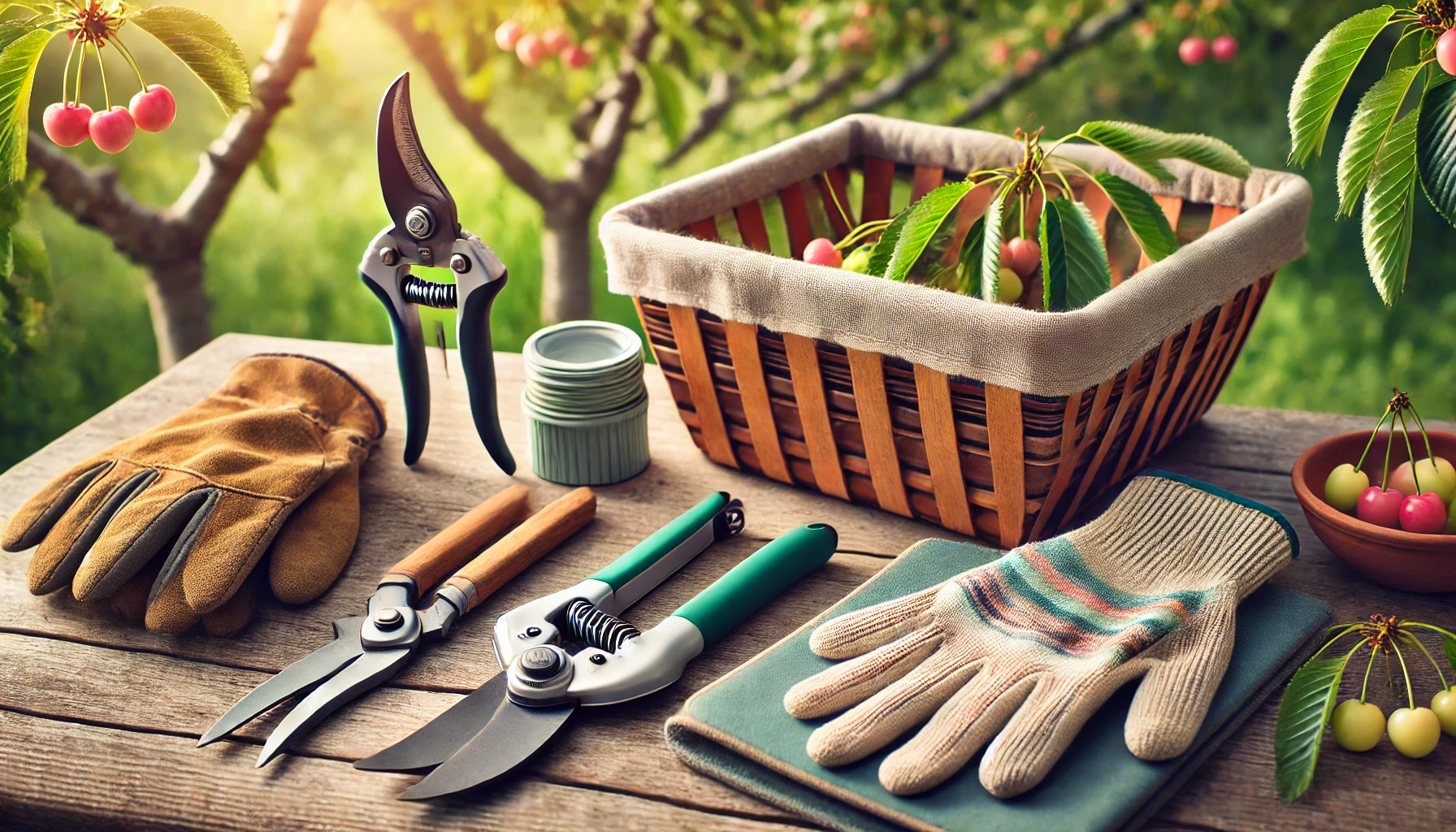
- Pruning Saw
For thicker branches or tougher plants, a pruning saw comes in handy. It provides clean cuts, helping to prevent damage to the plant and reducing the risk of infection. - Harvest Basket or Bag
A lightweight, breathable basket or bag is ideal for gathering your harvest without crushing delicate fruits or vegetables. Choose one with handles for easy carrying. - Gardening Gloves
Protect your hands from thorny plants, rough surfaces, and sharp edges with a good pair of gardening gloves. Look for gloves with grip for better handling. - Kneeling Pad or Stool
Harvesting low-lying plants can strain your knees and back. A comfortable kneeling pad or portable stool helps maintain proper posture and reduces discomfort. - Hose or Watering Can
Watering your plants before harvesting can make the process smoother, especially for root vegetables. It loosens the soil and makes picking easier.
By having these tools on hand, you’ll be able to harvest your plants efficiently and safely, minimizing the risk of injury or damage to your crop.
Step-by-Step Guide to Harvesting Cherries Without Damaging Your Tree 

Harvesting cherries correctly is crucial to preserving your tree’s health and ensuring a bountiful crop next season. Follow these easy steps to pick cherries safely and efficiently:
- Choose the Right Time
Wait until the cherries are fully ripe—bright red for sweet varieties and slightly darker for tart ones. They should be firm to the touch and easy to pull from the tree. - Use the Right Tools
A pair of sharp, clean pruning shears is ideal for harvesting cherries. This helps you avoid crushing or bruising the fruit.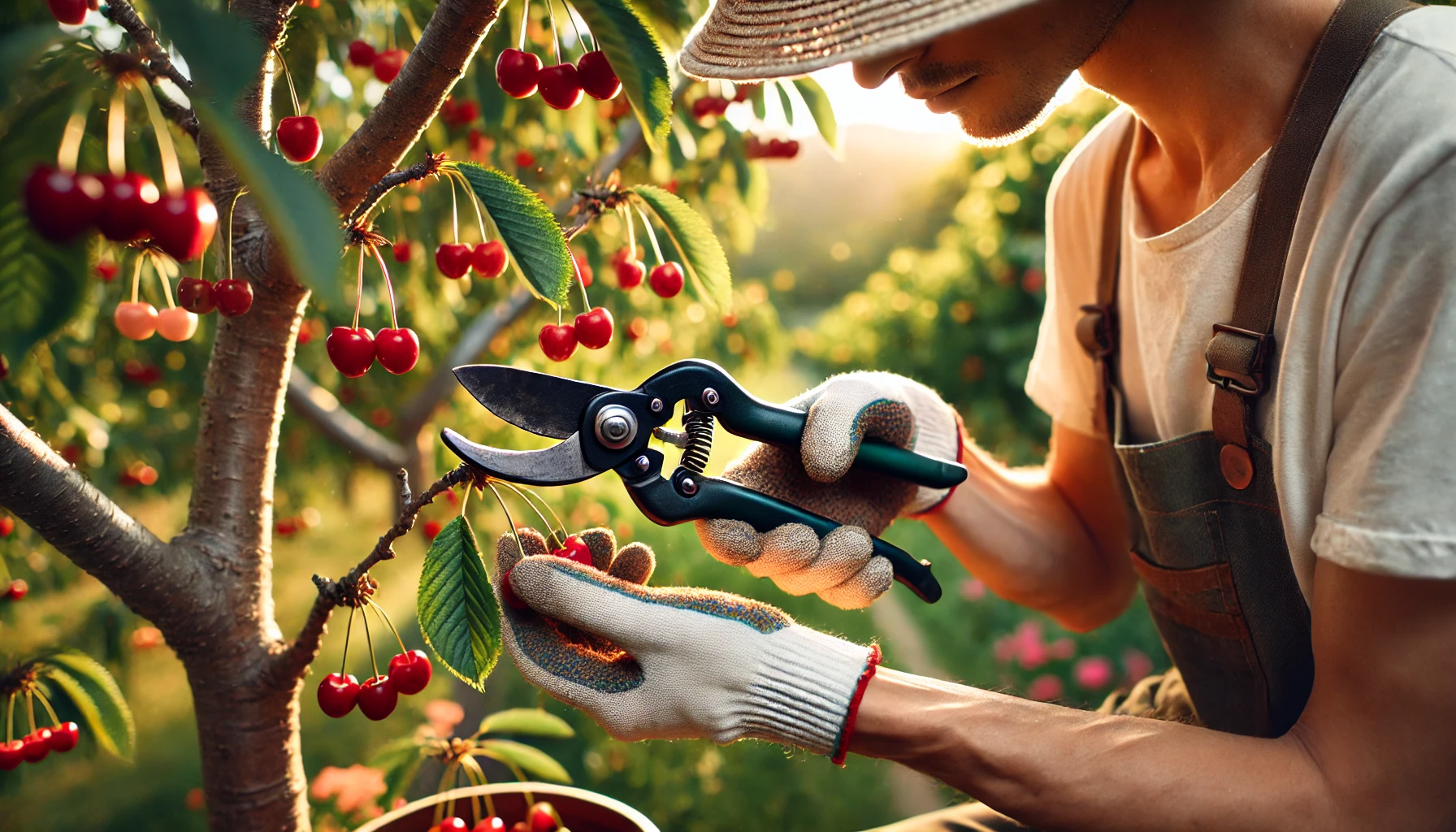
- Gently Pull, Don’t Twist
Grasp the cherry by its stem and gently pull. Avoid twisting or tugging, as this can damage the tree branches or cause unripe cherries to fall prematurely. - Pick in Small Batches
Harvest cherries in small batches to prevent overloading the tree. Too many cherries at once can stress the branches and cause breakage. - Protect the Tree’s Branches
If your tree has heavy fruiting branches, support them with soft ties or even a sturdy ladder for better access. Avoid standing directly on branches to prevent damage. - Handle With Care
Place the harvested cherries gently into a basket or container lined with soft material. Avoid dropping them as that could cause bruising. - Leave Some Fruit Behind
Don’t pick all the cherries. Leave a few behind for birds or as a natural seed source, ensuring the tree’s health and the local ecosystem.
By following these steps, you’ll keep your tree healthy and enjoy a sweet harvest year after year!
Handling Cherries After Harvesting 

Once you’ve harvested your cherries, the key to preserving their flavor and freshness is proper handling. Here’s how to keep your cherries at their best:
1. Handle With Care 
Cherries are delicate, so avoid bruising them. Gently place them in baskets or boxes with soft liners to protect the fruit.
2. Cool Down Fast 
Chill cherries immediately after harvesting. Place them in a cool, shaded spot or refrigerate them within an hour to prevent spoilage.
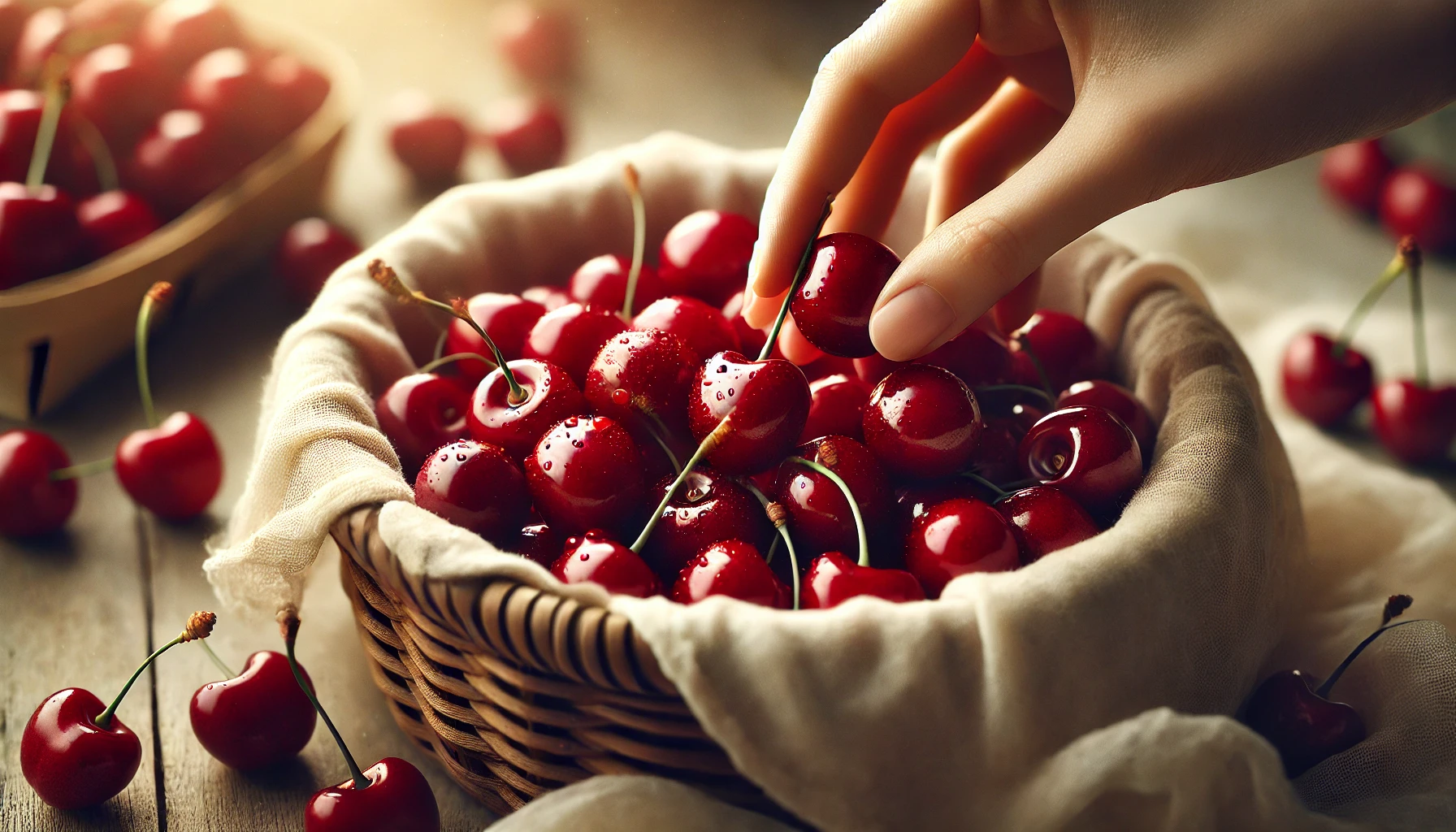
3. Store Properly in the Fridge 
For short-term storage, keep cherries in the fridge in a perforated plastic bag or container. This will help them stay fresh for up to 7 days.
4. Avoid Washing Before Storing 

Washing cherries before storage can cause them to spoil faster. Only rinse them right before you’re ready to eat or process them.
5. Freeze for Long-Term Storage 

If you want to preserve cherries for a longer time, freeze them. Pit them first, then spread them on a baking sheet to freeze individually. Once frozen, transfer them to a freezer bag. This method keeps them good for up to 12 months!
By following these steps, your cherries will remain fresh, tasty, and ready for use, whether you’re enjoying them fresh or using them in recipes!
Post-Harvest Tree Care 

Once you’ve harvested your tree’s fruits or leaves, proper care is essential to ensure the plant stays healthy and continues thriving for future seasons. Follow these tips for the best post-harvest tree care:
- Prune Dead or Damaged Branches
After harvest, check for any dead or damaged branches and remove them. This will prevent disease and pests from taking hold. Pruning helps the tree focus energy on healthy growth.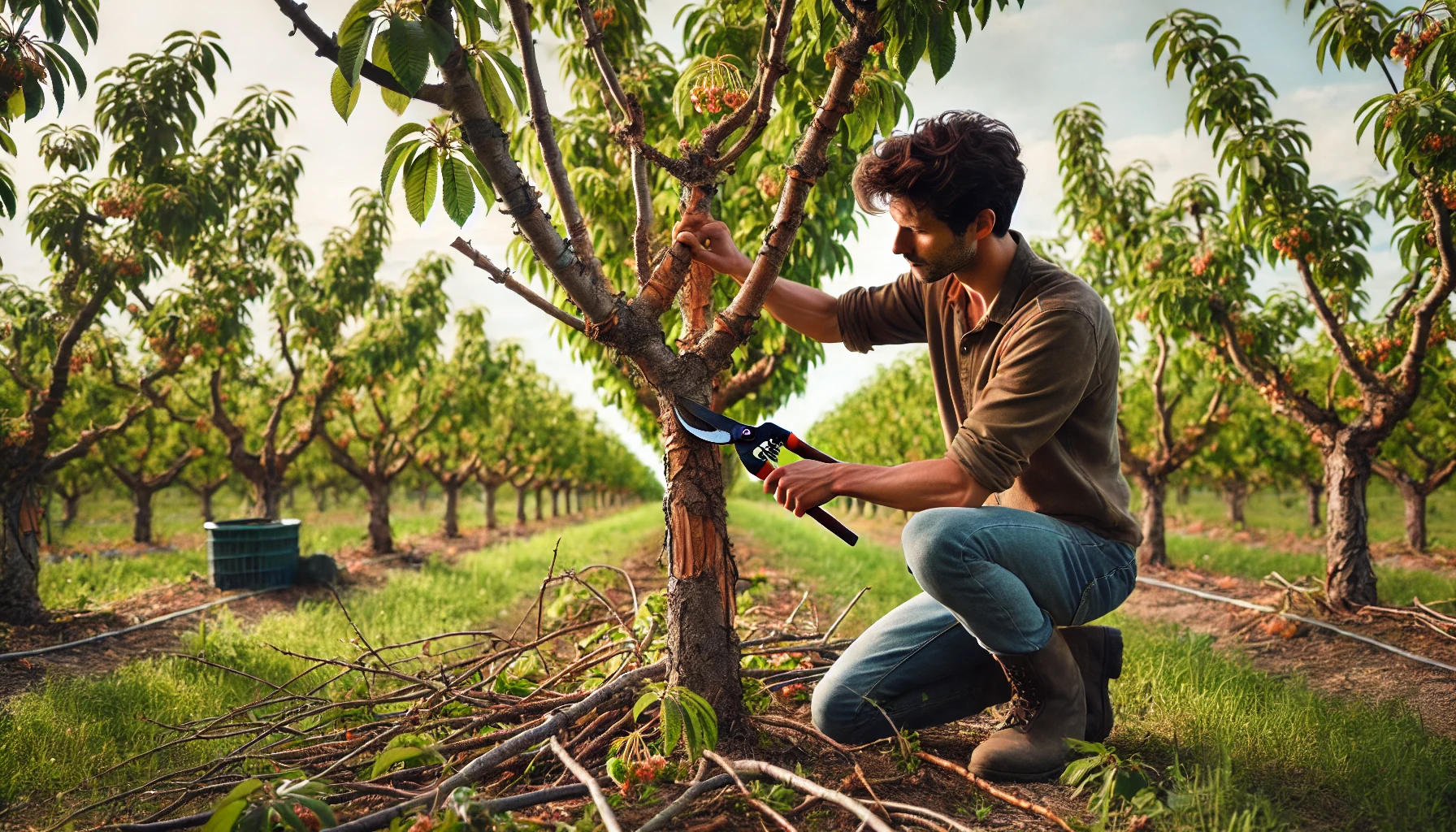
- Water Consistently
Keep the soil evenly moist but not waterlogged. Proper hydration is crucial for tree recovery, especially after fruiting. Adjust watering based on the tree’s needs and the weather. - Fertilize for Regrowth
Apply a balanced fertilizer to encourage new growth. Look for a slow-release formula to give the tree steady nutrients. Avoid over-fertilizing, as this can lead to excessive growth at the expense of the tree’s overall health. - Mulch to Retain Moisture
Apply a layer of organic mulch around the base of the tree. This will help retain moisture, regulate soil temperature, and reduce weed growth, keeping your tree’s roots happy. - Check for Pests and Diseases
Regularly inspect your tree for signs of pests or disease. If you spot any issues, treat them promptly with organic pesticides or natural remedies. - Give Your Tree Rest
Trees need a recovery period after a harvest. Avoid over-stressing your tree by reducing heavy pruning or excessive fertilizing during the post-harvest period.
By following these simple steps, you’ll ensure your tree stays healthy and productive for many harvests to come!
Common Mistakes to Avoid When Harvesting Cherries 

Harvesting cherries can be tricky if you’re not aware of common mistakes. Avoid these missteps to ensure you get the best yield:
- Picking Too Early
Cherries should be fully ripe before picking. If you harvest them too early, they’ll be tart and underdeveloped. Check the color (they should be deep red or yellow, depending on the variety) and taste a sample to ensure sweetness. - Using the Wrong Tools
Don’t pull cherries off the stem with your hands. This can damage the fruit or tree. Instead, use garden shears or gently twist the stem to avoid tearing. - Ignoring the Weather
Avoid harvesting during rain or extreme heat. Wet cherries are more likely to spoil, and harvesting in hot weather can cause premature ripening. Opt for a dry, cool day to pick your cherries. - Harvesting Too Roughly
Be gentle! Rough handling can bruise the cherries, leading to quick decay. Handle the fruit carefully, placing them into containers without pressing them down.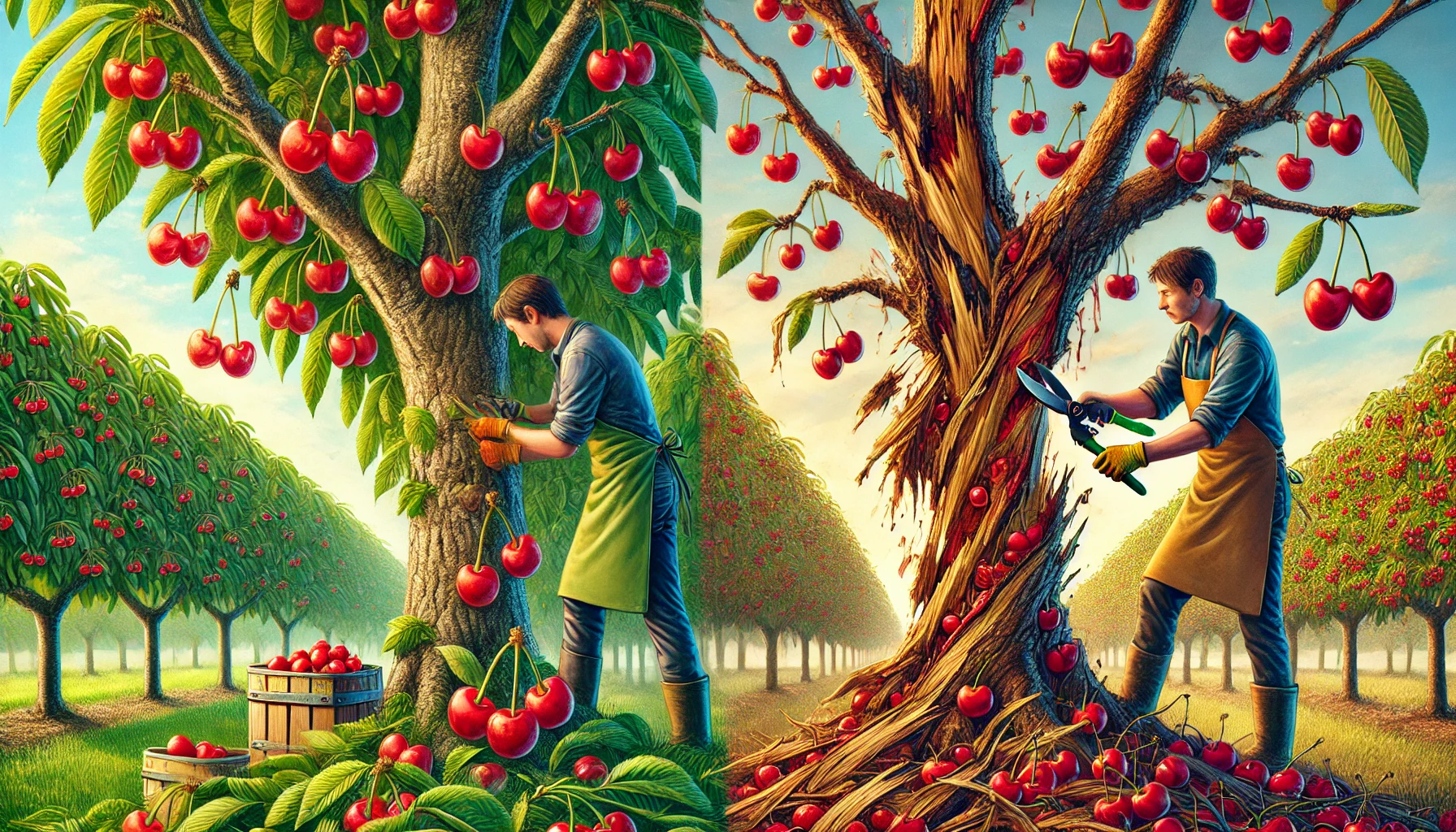
- Not Checking for Pests
Always inspect your cherries for pests or damage before picking. Pests like birds, insects, or even mold can reduce the quality of the fruit. - Harvesting the Entire Tree at Once
Not all cherries ripen simultaneously. Pick them in stages, starting with the ripe ones. This method helps you avoid wasting unripe fruit.
Avoid these mistakes, and you’ll enjoy a bountiful cherry harvest!
Conclusion 

Harvesting cherries is more than just picking fruit; it’s about ensuring your tree stays healthy for seasons to come while enjoying the delicious results of your hard work. By following the Best Ways to Harvest Cherry Fruit Without Damaging Your Tree, you’re not only protecting the integrity of your tree but also improving the overall quality of your harvest. From choosing the right tools to harvesting at the perfect time, every step you take has a lasting impact on both your tree’s future and your future cherry yields.

Remember, careful harvesting ensures that your cherry tree continues to thrive year after year, producing abundant fruit that will satisfy your garden’s needs. So, take the time to harvest with precision and care—you’ll be rewarded with delicious cherries and a healthy, thriving tree!
Happy harvesting, and may your cherry trees flourish!
Frequently Asked Questions(FAQ)
What’s the best tool for harvesting cherries?
The best tool for harvesting cherries is a pair of sharp, clean pruning shears or snips. These tools allow you to cut the cherry stems cleanly without damaging the fruit or the tree.
How do I know when my cherries are ready to be picked?
Cherries are typically ready for harvest when they reach their full color—bright red or yellow, depending on the variety—and are firm to the touch. You can also taste a sample to check for sweetness and flavor.
Can I use a ladder to pick cherries without hurting the tree?
Yes, you can use a ladder to reach higher branches, but be sure to move it carefully to avoid damaging the tree. Never shake the tree or use excessive force to pull branches down.
Is it okay to shake the tree to harvest cherries?
Shaking the tree is not recommended, as it can damage branches, cause premature fruit drop, and even harm the tree’s overall health. Always harvest gently to avoid stressing the tree.
How do I prevent bruising while handling cherries?
To prevent bruising, use soft baskets or buckets to collect cherries, and avoid overloading them. Handle the fruit gently, and store it in a cool, dry place immediately after harvesting.
Should I prune my cherry tree after harvesting?
Light pruning can be beneficial after harvesting, as it helps remove dead or damaged branches, allowing for better airflow and sunlight penetration, which promotes healthier growth for next season.
Can I harvest cherries in multiple rounds, or should I pick them all at once?
It’s perfectly fine to harvest cherries in multiple rounds. Cherries ripen at different times, so picking them in stages ensures you get the best quality fruit and reduces the risk of overripe cherries.



















